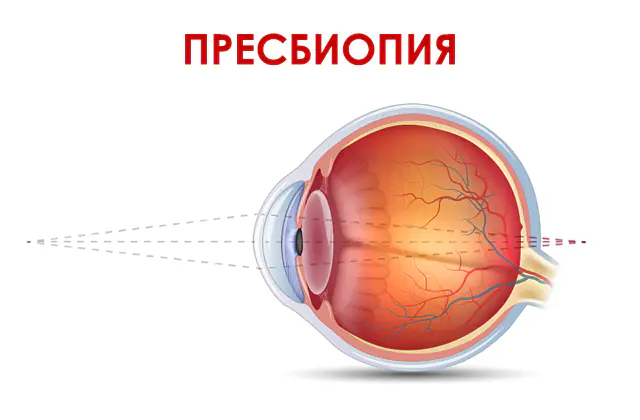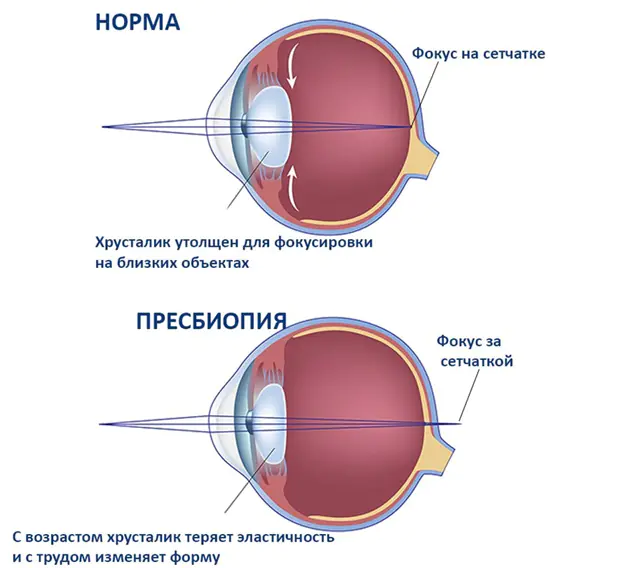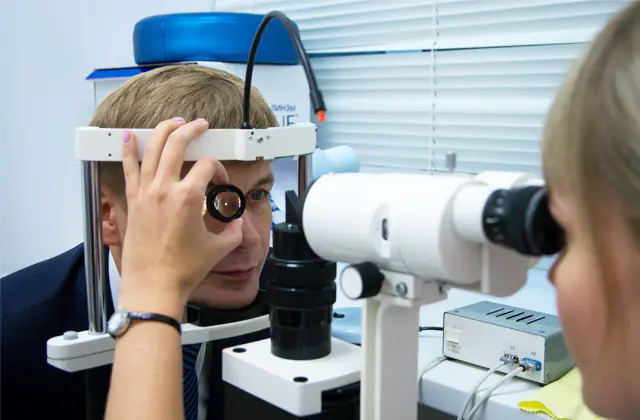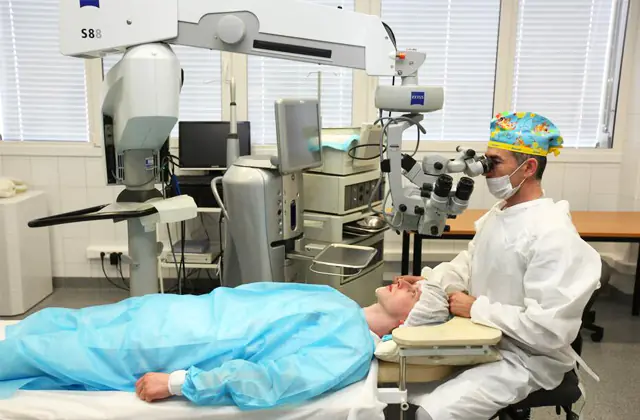
Description and causes of eye presbyopia. Main symptoms and diagnosis. Contact correction, treatment methods, prevention.
The content of the article:- What is presbyopia
- Symptoms and diagnosis
- Treatment options
- Optical and contact correction
- Surgical intervention
- Prevention
Presbyopia is a natural physiological condition that affects the clarity of near vision. In this case, the patient experiences difficulty reading, using a mobile phone, or using a computer. Another name is age-related farsightedness.
What is eye presbyopia?

Presbyopia is not a pathological condition or disorder. This is a natural process that can progress at different speeds, but sooner or later it manifests itself in everyone, when there is a gradual decrease in the elasticity of the lenses and difficulty focusing at close distances.
At a young age, the lenses of the eyes have the necessary properties to see objects, letters, and the environment quite clearly. They are soft and flexible, prone to rapid change in shape, so a person can immediately see objects of various sizes at different distances.
However, over time, the lenses lose their density and elasticity, and the flexibility and ability of the eyes to adapt decreases. This leads to the diagnosis of “presbyopia,” which affects most people over 45 years of age.
Patients with a history of farsightedness tend to develop presbyopia earlier.
Important! If cataracts, farsightedness or myopia develop against the background of presbyopia, surgical intervention is indicated.Ophthalmologists describe the following mechanism of development and causes of presbyopia:
- As the human body ages, the lenses become denser, lose elasticity and the ability to view objects located at close range;
- The organs of vision lose their ability to adapt to environmental conditions;
- There is a weakening of the muscle tissue that supports the lenses;
- When the occipital lobe of the brain, responsible for the functioning of the visual organs, begins to send signals to the muscle tissues, they cannot affect the shape of the lens;
- As a result, it is not possible to focus the image of a nearby object on the retina, and complaints of blurred vision arise.
Symptoms and diagnosis of presbyopia

Patients often ignore the first symptoms of presbyopia, attributing them to age and chronic fatigue. However, over time, the clinical picture worsens.
A characteristic symptom of presbyopia is blurred vision. This leads to:
- With presbyopia, vision becomes blurred and unclear;
- difficulties arise when viewing objects close up;
- there is a need to move objects to a far distance in order to get a good look at them;
- The organs of vision are subject to excessive stress and get tired quickly.
With the development of age-related farsightedness, the patient cannot read, use mobile devices, embroider and perform other activities that require good near vision. The ability to read small print is lost: the letters blur and become unclear. If a person puts excessive effort into trying to read or work on a computer, there is a chance of developing a headache.
Important! People over 50 years of age, as well as patients with a history of diabetes mellitus and other endocrine disorders, are recommended to visit an ophthalmologist in a timely manner. The described symptoms of presbyopia may also indicate the development of cataracts, myopia and other ophthalmic pathologies that are more dangerous than age-related farsightedness.Timely diagnosis allows not only to differentiate presbyopia from cataracts and myopia, but also to select suitable glasses and lenses to correct the disorder. The doctor examines the patient and conducts an oral interview. Particular attention is paid to chronic pathologies that the patient has in the medical history, especially diabetes mellitus and other endocrine disorders. With uncompensated diabetes mellitus, there is no point in starting treatment for presbyopia, since the clinical picture will worsen.
Next, the doctor prescribes standard ophthalmological examinations:
- Visometry- a simple and affordable procedure with which you can determine visual acuity. Use a table with letters of different sizes printed on it.
- Refractometry- a technique by which the ability of the organs of vision to refract light rays with their further fixation on the retina is determined. Allows you to identify farsightedness and nearsightedness.
- Ophthalmoscopy— during the procedure, the doctor examines the fundus of the eye using special optical instruments. The condition of the retina, as well as the optic nerves and blood vessels are assessed.
Depending on concomitant complaints and medical history, advanced diagnostics may be prescribed. The list of diagnostic procedures is selected individually. Regular diagnostics are indicated for people over 45 years of age and those who use contact lenses, pregnant women, patients with a history of diabetes mellitus, and cardiovascular pathologies.
Treatment options for presbyopia
During the correction of presbyopia, attention is paid not only to the degree of progression of the condition, but also to the lifestyle that the person leads, as well as his age and type of activity. Treatment involves the use of glasses or contact lenses. To correct the condition, it is recommended to use magnifying glasses and reading glasses. With presbyopia, exercises are not able to reverse the aging process of the visual organs, as well as the use of traditional medicine recipes. To compensate for accommodation and the focal length of the crystal, different types of lenses are used: bifocal (corrects vision at close and far distances), trifocal (corrects vision at close, medium and far distances). When using progressive devices, the upper part of the lens is used to correct distance vision, and the lower part is used to correct near vision.
Optical and contact correction of presbyopia

The treatment regimen is selected depending on the degree of presbyopia and the clinical picture. If there are complaints about deterioration of near vision, but a person sees objects well in the distance, it is recommended to use glasses for working at close range. This is an effective and affordable method that allows you to correct age-related presbyopia.
If there is a history of myopia, the patient experiences difficulty viewing objects both at close and far distances. For this purpose, when treating presbyopia, it is recommended to use bifocal glasses: one part corrects near vision, the other corrects distance vision. It is advisable to have several pairs of glasses, each of which can be used for different types of activities.
If the patient does not have the ability or desire to use glasses, it is recommended to purchase contact lenses for presbyopia. Multifocal lenses are equipped with a peripheral and central zone, which are responsible for normalizing vision clarity. This correction method expands the field of view without deforming it. Thanks to high-quality innovative materials, the toxic load on the organs of vision and the entire body as a whole is reduced. Additional use of glasses while using lenses is not required.
Surgery for presbyopic eyes

If bifocal, trifocal or progressive lenses are ineffective, as well as other pathological eye conditions, the installation of an intracorneal lens is indicated. Laser correction of presbyopia in this case is ineffective. The doctor uses clear lenses with a diameter of up to 1.9 mm. They are placed in the central part of the cornea to compensate for the violation of its sphericity. The depth and sharpness of vision increases, the ability to see at close range is normalized.
During the operation, different types of lenses are used:
- When the elasticity of the lens decreases, intraocular lenses are used. The operation is performed within 20-30 minutes using local anesthetics. The doctor makes a micro incision up to 1.5 mm and inserts a lens. After completion of the presbyopia surgery, the resulting access is self-sealing. The procedure is low-traumatic, there is no need for sutures. The patient can quickly return to his normal lifestyle.
- The multifocal lens has a special design that imitates the natural functioning of the lenses of the eyes, and is the best vision correction for presbyopia. The main advantage of this type of lens is the ability to see objects at different distances, thanks to several optical focuses. After such an operation, the patient's quality of life is significantly improved: there is no need for additional use of glasses or contact lenses to read, write or work with small objects.
- Accommodating lenses are as similar as possible to the physiological lens of the eye. They feature a unique design that allows the eye muscles to continue to move and flex, mimicking natural focusing properties. This type of lens promotes natural accommodation (adaptation) of the visual organs to external conditions.
To normalize near vision, the use of intracorneal lenses is recommended. Over time, they can be removed and replaced with others. The optical power of artificial lenses is selected individually for each patient. In this case, they take into account the state of the visual system, the age and type of activity of the patient, and the presence of concomitant diseases. This procedure is often performed to treat other age-related changes in the organs of vision.
Presbyopia surgery helps prevent cataracts because artificial lenses do not darken over time.Preventing presbyopia

There is no specific prevention for the development of this condition. People of any age are recommended to regularly undergo an in-person examination with an ophthalmologist. For presbyopia, drops are not able to prevent or slow the progression of the condition. Patients over 40 years of age are at risk because they are more susceptible to age-related changes.
If the patient prefers to use glasses to correct visual impairment, it is recommended to purchase them only in specialized stores with medical supplies after a comprehensive diagnosis and receipt of a prescription from a doctor. Poor quality products can negatively affect the clarity of vision and aggravate the clinical picture.
Video: what is eye presbyopia and how to treat it:



